
Power and telephone lines sag after a heavy ice storm on planet Earth. Credit: NOAA
Earth has dreadful weather.
Sometimes winds rip the roofs off houses or pick up cars and drop them miles away. In some places it rains so hard you could almost drown by looking up at the sky. There are deserts where it gets hot enough to fry eggs on a rock . . . in other locales, it can be cold enough to freeze the tears on your eyelashes.
Is there someplace else we could go to get away from this wild Earth weather?
Weather Tour of the Solar System

Credit: NOAA/JPL-Caltech
The hottest day that we know of on Earth was July 10, 1913. On that day, Death Valley, California, reached 134º F. If that isn't hot enough for you, try Venus. The thick atmosphere of carbon dioxide on Venus turns it into a greenhouse (but without the happy plants). The atmosphere holds in the Sun’s heat and never lets the planet cool off, even at night. Surface temperatures are almost 900º F—hot enough to melt lead!
As a vacation spot, Venus is definitely out.
So, where shall we go to cool off?
A Refreshing Mars Stop
How about Mars? It’s farther from the Sun than Earth is, and the air is very thin. So it will be cool and refreshing like on a mountain top, right?
Wrong!
Yes, it’s cool. The daytime, summer temperatures get only up to about 80º F. But at night, the temperature can drop to almost -200º F (that’s 200º below zero!). It actually did get almost as cold as Mars once on Earth: Vostok, Antarctica, recorded a low of -129 º F on July 21, 1983. But on Mars, this sort of weather occurs all the time, swinging from warmest to coldest in one day!
Why such wild swings? The air (if you could call it that) on Mars is made mostly of carbon dioxide. But the air is so thin (less than 1/100th as thick as Earth’s air) that the heat from the daytime Sun escapes into space at night. This thin air can still kick up a huge dust storm. The whole planet can be wrapped in clouds of fine Martian dust for weeks at a time. In calmer times, whirly winds stir up the fine soil, making “dust devils” that dance across the Martian surface.
So, Mars’ weather isn’t much fun either.
Skating Anyone?
If you’re going to be cold anyway, you can at least go somewhere with great winter sporting opportunities. If you ice skate, how about Europa? Europa is one of the four largest moons of Jupiter. It’s a little smaller than Earth’s Moon. But it’s covered in ice—smooth ice! It’s gravity is only about 1/8th of Earth’s, so imagine the height you could get on a triple axel! Unfortunately, with Europa temperatures around -328º F, you would be frozen hard as a rock in a nanosecond.
Brrrr! Our search for better weather in the solar system isn’t looking promising.
A Long Hurricane Season
Perhaps you've always wondered what it would be like to be inside a hurricane. On Earth, the strongest ever recorded hurricane winds blew at around 200 miles per hour. Well, Jupiter's Great Red Spot would give you a whirlwind ride like you would never find on Earth. Counterclockwise winds of about 250 miles per hour blow clouds high in Jupiter's atmosphere into a beautiful, swirling pattern. The Red Spot could swallow up two whole Earths. This storm has been raging for at least 300 years!
But even 250 miles per hour is a gentle breeze compared to our next stop.
Breezy - But Beautiful!
Saturn is so beautiful from Earth, even through a small telescope, with its lovely rings and bands of clouds. Those clouds are moving at different speeds—of around 1,100 miles per hour! Some blow eastward, some blow westward. Oh, and it’s cold on Saturn too, although not quite as cold as Europa. Then there’s the small problem that, Like Jupiter, it’s a gas giant, so there’s no solid ground to stand upon.
Well, beauty isn’t everything.
Land o' Lakes
Now Saturn’s moon Titan, at first glance, looks promising. It’s the second largest moon in the solar system, after Jupiter’s moon Ganymede. Titan is covered in thick, hazy clouds. So, does it rain on Titan? Let’s dive under the clouds and see. Oh, look—lakes! Liquid lakes! Does that mean it’s warm enough for water to be a liquid? Alas, no. The lakes are filled not with water, but with liquid methane or ethane.

Titan may have a "methane cycle" (or "ethane cycle") like Earth's water cycle. Credit: NOAA/JPL-Caltech
We have methane here on Earth too, but as a gas—sometimes known as marsh gas. To “freeze” into a liquid and rain out of the clouds on Titan, the methane must be colder than -296.5º F. Oops! Clouds, rain, and pretty lakes are no guarantee of a friendly, Earth-like environment.
So let’s keep going.
The Windiest
We’ll just skip methane-blue Uranus, because it’s another really windy gas giant. Same with Neptune, except even more X-treme! Neptune’s winds are the fastest in the solar system, reaching 1,600 miles per hour! Neptune has been known to have giant, spinning storms that could swallow the whole Earth.
The Iciest

Credit: NOAA/JPL-Caltech
One of Neptune’s moons, Triton, might be worth checking out. At least it’s solid and it has an atmosphere—barely. And its atmosphere even has something in common with Earth’s. It is mostly nitrogen. The only other body with a mostly nitrogen atmosphere is Saturn’s moon Titan. Triton’s unique ice volcanoes might make it a fascinating tourist stop. However, with a surface temperature of -391º F, this moon is one of the coldest objects in the solar system!
Let's Go Home!

Credit: NOAA
Well, Earth is starting to look like an ideal vacation spot, in spite of its “wild weather.” The most important thing in dealing with Earth’s extremes is to be prepared.
Part of being prepared is knowing when bad weather is on the way. That's one of the main jobs of weather satellites in the GOES-R series. GOES-R series stands for Geostationary Operational Environmental Satellite-R series. These satellites are in geostationary orbit watching over North America. Their geostationary orbits are very high—22,300 miles high—right above the equator. As Earth turns on its axis, the satellites seem to hover over the same spot on Earth all the time. Really, the satellites are making one Earth orbit per day.
The GOES-R satellites are operated by the National Oceanic and Atmospheric Administration (NOAA). NOAA is also in charge of the National Weather Service. They let people know what kind of storms or other weather is coming their way.
The GOES-R series help with other things as well. They have instruments to study the sun, so we know when bad "space weather" is on the way too. These satellites are also part of a world-wide search and rescue system for hikers, planes, and boats when they are lost or in trouble.
No, Earth isn’t the only planet with weather. But it’s by far got the best.












